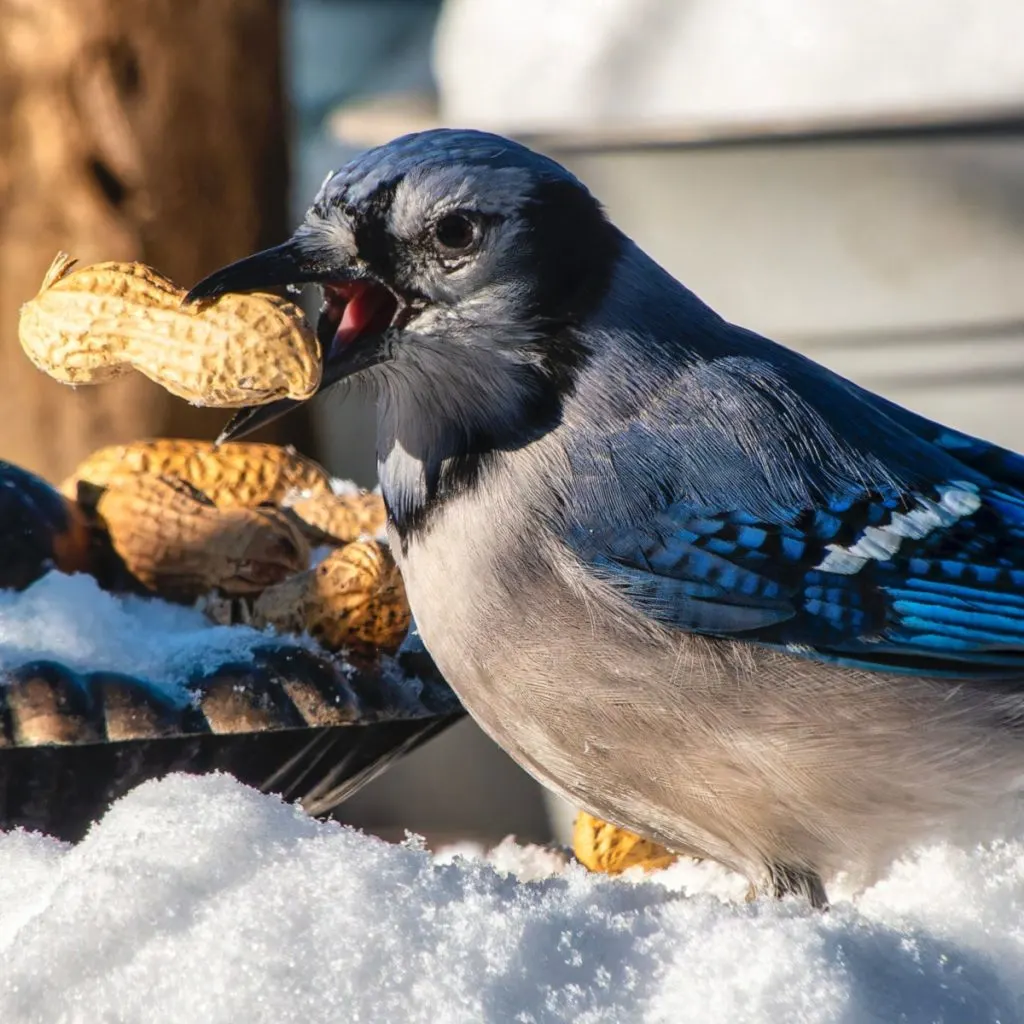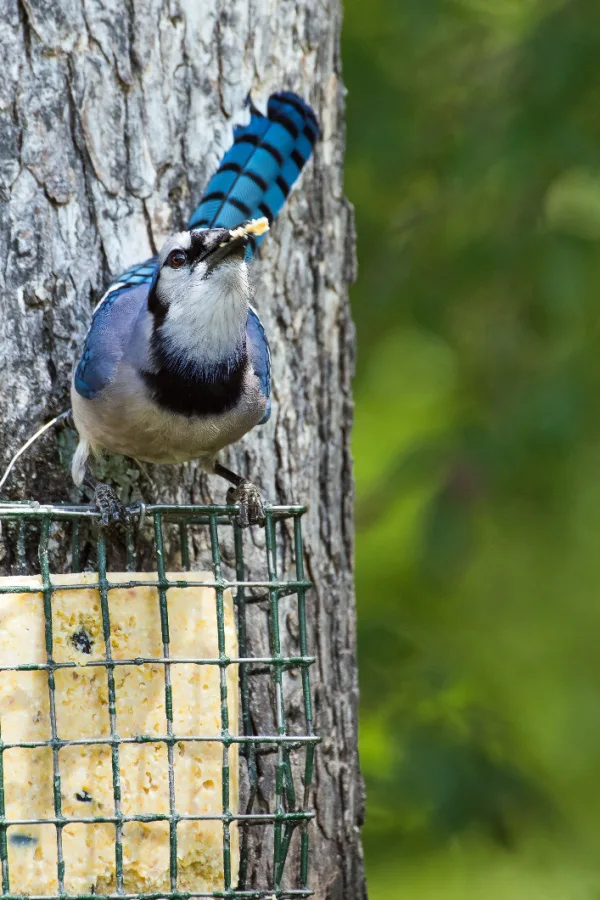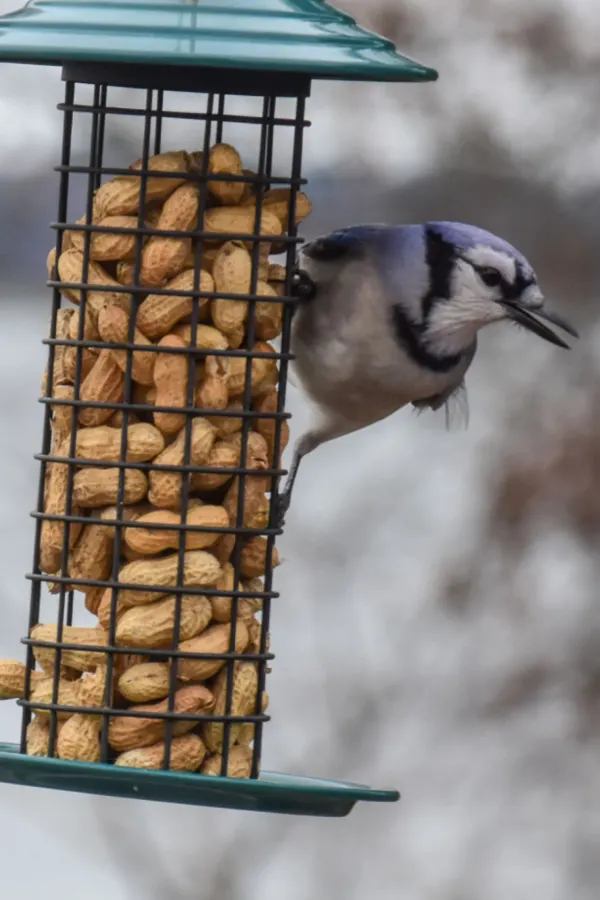Looking for a few ways you can help those beautiful blue jays flying around your yard survive and thrive all winter long – while still keeping all of the other birds safe too?
Blue jays are certainly vibrant and intelligent birds. And are they ever a delight to observe, especially during the colder months when their brilliant blue feathers and white bellies contrast beautifully with the barren winter landscape.
Blue jays are not just beautiful but incredibly smart, often displaying clever behaviors that highlight their resourcefulness. They’re known for their loud calls and flashy antics, making them entertaining to watch. But although their bold personalities and playful behaviors make them favorites for bird watchers – their assertiveness can sometimes create challenges in the backyard for other birds. Especially at feeders!

With that said, much like cardinals, woodpeckers, chickadees and other non migratory birds, blue jays struggle to find the food and shelter they need to survive winter. And just like those birds – they can benefit from a little help from us to get them through.
The good news is that there a few simple ways you can help make all of the birds in your winter landscape happy. And even more – keep them all healthy and strong as well. Success really comes down to knowing how, what and where to feed all of them to keep inter-bird conflict away!
How To Help Blue Jays Survive Winter – And Still Keep Other Birds Safe!
A blue jay’s dominant nature can often make them intimidating to smaller birds. One of the most fascinating behaviors of blue jays is their ability to mimic hawk calls, a clever tactic they use to scare off other birds from feeders.
While their intelligence is impressive, it can lead to issues when you’re trying to maintain a peaceful feeding station that accommodates a wide variety of bird species. But that is exactly where creating a separate feeding area for jays can save the day!
With a few thoughtful adjustments to your feeding setup and food choices, you can create a balanced environment that meets the needs of all your feathered visitors. Success all comes down to providing the right feeders, the right food, and a little bit of space.

Creating A Separate Feeding Area For Blue Jays
The first step to success is to provide a separate area for feeding blue jays. It’s important to position this feeder away from your primary feeding stations to reduce competition and prevent the jays from dominating all the feeding spaces. And even more, to fill it with the feed jays love most!
Blue jays are larger than many backyard birds, so they need sturdy feeders that can support their size and weight. Platform feeders and tray feeders are excellent choices. Both provide ample landing space and can hold the foods blue jays love.
Opt for feeders made of durable materials like metal or heavy-duty plastic to ensure they withstand the wear and tear from these robust birds.
The Best Foods For Blue Jays – How To Help Blue Jays Survive Winter & Still Keep Other Birds Safe!
When it comes to food, blue jays have specific preferences that make it easier to cater to them while diverting their attention from other feeders. Peanuts are a favorite treat, whether in the shell or out. They provide a rich source of protein and fats that are especially beneficial in cold weather.
A peanut wreath feeder is also an excellent option, as it allows the jays to enjoy their favorite food while discouraging smaller birds that aren’t as interested in peanuts. Affiliate Link: Hugeleaf 2 Pieces Peanut Bird Feeder, Hanging Wreath Feeder
Sunflower seeds, particularly black-oil and striped varieties, are another favorite for blue jays. Dried or cracked corn is also a great option and offers high carbohydrate nutrition for jays.
Listen In To Our Podcast Below On Feeding Birds In The Winter
In addition to these staples, suet is an excellent choice for blue jays in the winter. Look for suet cakes that include nuts or fruits to provide an extra boost of energy and nutrition. You can also make your own suet right at home quite easily. See: How To Make Homemade Bird Suet
Mealworms, whether dried or live, also make a fantastic high-energy treat. Interestingly, while blue jays are happy to feed from platforms or feeders, they also enjoy foraging on the ground. Scattering some food near bushes or trees can give them another option and help keep them occupied.
Keeping Smaller Birds Happy – How To Help Blue Jays Survive Winter & Still Keep Other Birds Safe!
For smaller birds, the key is offering foods that blue jays aren’t as interested in. Seeds like nyjer seeds and safflower seeds are perfect for this. These seeds are favorites for finches, chickadees, and other small birds but tend to be ignored by blue jays.
Using caged feeders can also help protect smaller birds. The cages keep larger birds like blue jays from accessing the food inside. This way, the smaller birds can eat in peace without feeling threatened.
Consistent feeding is also important. Blue jays will start to rely on steady food sources during the colder months. As will the smaller birds in the feeders kept away from the blue jay areas. Keep all feeders stocked – and be sure to provide fresh water, as hydration is just as vital as food.

Last but not least, no matter what birds you are feeding, it’s important to keep feeders clean. Especially during the winter when they rely on the food sources almost entirely.
It’s best to clean feeders with warm, soapy water and disinfect them monthly. The easiest way to do this is with a bleach solution of one part bleach to ten parts water. In addition, clean up shells and leftover food to prevent mold and bacteria from accumulating.
Here is to feeding all of the birds in your yard this winter – including blue jays!
This Is My Garden
Follow Our Facebook Page For Great Gardening Tips And Advice! This Is My Garden Facebook Page
This Is My Garden is a garden website created by gardeners, for gardeners. Jim and Mary Competti have been writing gardening, DIY and recipe articles and books and speaking for over 15 years from their 46 acre Ohio farm. They publish three articles every week, 52 weeks a year. Sign up today to follow via email, or follow along!
